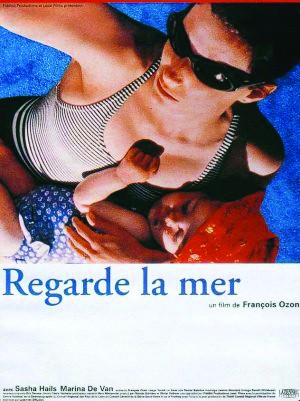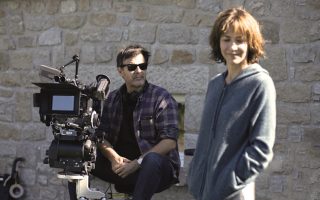The Heat of Summer: Top 5 French Films

Ray of Sunshine
Le Rayon Vert (1986), The Green Ray, Eric Rohmer
The first of two Rohmer ‘Comédies et Proverbs’ featured here sees Marie Rivière play Delphine, a lonesome yet defiant singleton secretary in a world of couples and pitying fools. As the moral barometer of the piece, Delphine is horrified at the thought of one-night stands and recoils in disdain at pre-planned lines thrown at her by sleazy men in bars and on trains. As she seeks out the perfect summer holiday, Delphine seems bored a lot of the time, perhaps irritated at the misconceptions which society holds concerning single women and the way they are expected to behave.
Leaving a stifling Paris for the summer, after a failed Cherbourg trip and an aborted jaunt to the Alps, while in Biarritz she overhears a conversation about Jules Verne’s Le Rayon Vert, which concerns a green flash at sunset that means “you can read your own feelings and others’ too”. Will she get a glimpse and find love at last?
Some Like it Hot
L’Été meurtrier (1983), One Deadly Summer, Jean Becker
This sultry tale of a vengeful femme fatale with more than love on her mind in a sweltering Alpes-Maritimes during the late-1970s is sourced from Marseille-born Sebastien Japrisot (a nom de plume that’s an anagram of his given name, Jean-Baptise Rossi), the novelist who would later pen the well-loved novel, A Very Long Engagement.
Isabelle Adjani is perfectly cast as Elle, a too-hot-to-handle, Marilyn Monroe-obsessed ingénue who arrives in a small town with her Mother and disabled Father.
She uses her considerable (frequently unclothed) charms, to woo a timid mechanic, Pin-Pon (played by shaggy-haired chanteur Alain Souchon), who may or may not hold clues to a horrific secret relating to her Mother.
When Elle’s assumptions prove wrong, both she and Pin-Pon lose the plot – unlike Japrisot, who steers us teasingly with multiple narrators towards a most unseemly ending.
Life’s a Beach
Pauline à la Plage (1983), Pauline at the Beach, Eric Rohmer
This Eric Rohmer classic, the third of his Comédies et Proverbes films, goes easy on plot, driving everything via character, and has all that a French summer film requires. You will feel for the lovelorn teens (notably Pauline, played with compellingly naive charm by Amanda Langlet) who fare no better in the holiday romance stakes than their promiscuous, pompous and pseudo-intellectual adult counterparts; enjoy lots of lingering shots of sun-soaked Breton beaches which fill the conversational holes; squirm at the elements of farce as double standards bite the grown-ups on their bronzed derrières; and wallow in the lovely naturalistic performances of actors delivering Rohmer’s quietly penetrating dialogue. A great advert for the Brittany Tourist Board, this film is proof that, even for the French, it’s very hard to keep your cool when summer comes.
Having a Night-Mer
Regarde la mer (1997), See the Sea, François Ozon
This early work by Ozon, who today is one of France’s most revered and interesting film directors (Potiche, Swimming Pool, In the House), may seem like an odd choice for our summer movies round-up. True, feel-good it isn’t, but summertime is a key player in this movie’s scenario. When else would drifter (Marina de Van) knock on the door of an isolated île de Yeu farmhouse where an Englishwoman, Sasha (Sasha Hails), lives with her 10-month old daughter, and ask to pitch her tent for a few days?
Sasha’s husband is away on business, so she agrees to let the wanderer stay. After a while she invites her into the house and an uneasy friendship begins. The stunning twist that follows in this short film – which is packaged with six more in a worthwhile DVD set – reveals Ozon’s bright cinematic future.
A Taxing Inheritance
L’Heure d’été (2008), Summer Hours, Olivier Assayas
This much-rewarded ensemble piece, which is set in Paris and was part-produced by the Musée d’Orsay, concerns family ties, loss, legacy, globalization and the value of ‘things’, both sentimentally and literally.
Three siblings gather at the familial home to discuss their ailing Mother’s affairs and possessions. As well as the sumptuously furnished house she occupies, Mama has also inherited a valuable art collection from her brother and wants the children to sort out what happens to it all when she is gone.
Frédéric (Charles Berling) wants to keep the collection together and find a museum to house it, while Jérémie (Jérémie Renier) and Adrienne (Juliette Binoche) – who are busy with their business and life in New York, respectively – have other ideas.
Remarkably, the Orsay lent some of the original artworks featured in the story, including a couple by Jean-Baptiste-Camille Corots of the Barbizon School.
Two more to watch…
Crustacés et Coquillages (2005), Cockles and Mussels, Olivier Ducastel
Monsieur Hulot’s Holiday (1953), Jacques Tati
From France Today magazine
Share to: Facebook Twitter LinkedIn Email
Leave a reply
Your email address will not be published. Required fields are marked *



